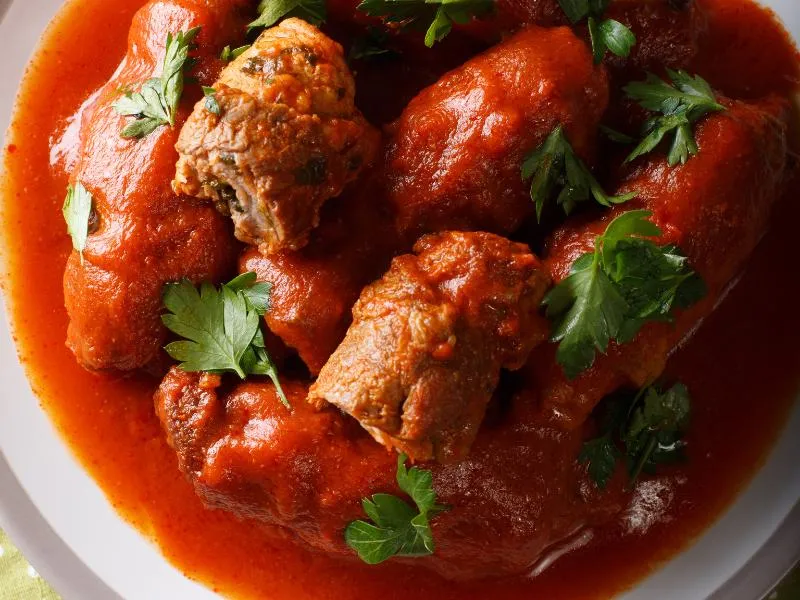Braciole
Thinly sliced beef rolled with herbs, cheese, and breadcrumbs, slowly braised in tomato sauce.
👉 View Authentic Recipe 👈
About This Dish
Braciole (singular: braciola) is a classic Southern Italian dish that originated in regions like Campania and Sicily, though variations exist throughout the country. The dish features thin slices of beef—traditionally flank steak or top round—pounded thin, then stuffed with a savory mixture of breadcrumbs, grated cheese (typically Pecorino or Parmigiano), herbs, and often pine nuts or raisins before being rolled, tied, and slowly braised in tomato sauce.
In Neapolitan cuisine, braciole is often a star component of the iconic “Sunday gravy” (ragù Napoletano), where the meat rolls simmer alongside other cuts like meatballs and sausage for hours, infusing the sauce with rich flavor. The name comes from the Italian word “brace,” meaning embers or coals, hinting at its origins as a dish cooked over open flame before evolving into the braised version common today.
Traditional family recipes for braciole are treasured and passed down through generations, with each household maintaining their signature filling combinations. The dish exemplifies the Italian tradition of transforming humble, tougher cuts of meat into tender, flavorful masterpieces through slow cooking techniques—a hallmark of cucina povera (peasant cooking) that has become celebrated in fine dining.
🧑🍳 Analyzed by CucinaBot
Why This Dish Works
Braciole exemplifies perfect culinary science: the long, slow braising breaks down tough collagen in the beef into gelatin, creating tenderness. Meanwhile, the tightly rolled structure allows the interior filling to infuse the meat with flavor while remaining moist. The browning of the meat before braising creates rich Maillard compounds that develop deep umami notes, while the tomato sauce provides acidity that further tenderizes the meat fibers and balances the richness of the dish.
Key Success Factors
- Proper Pounding: The meat must be pounded to an even, thin consistency (about 1/4 inch) to ensure uniform cooking and easy rolling
- Secure Tying: Using kitchen twine to tie the rolls at regular intervals prevents unraveling during the long cooking process
- Initial Searing: Browning the rolls thoroughly before braising develops essential flavor compounds and seals in juices
- Patience in Braising: Cooking low and slow (at least 2-3 hours) ensures the meat becomes fork-tender
Common Pitfalls
Many non-authentic recipes rush the cooking process or use pre-made sauce, missing the point that braciole is meant to flavor the sauce while cooking in it. Another common mistake is overstuffing the rolls, which can cause them to burst during cooking or create an unbalanced meat-to-filling ratio. Some versions also add ingredients like prosciutto or hard-boiled eggs that, while regional variations exist, are not considered traditional to the classic preparation.
How to Judge Authenticity
When reviewing recipes, look for these markers of authenticity:
- Uses tougher, less expensive cuts of beef like flank steak or top round
- Includes a simple filling with breadcrumbs, cheese, parsley, and perhaps garlic
- Specifies browning the meat rolls before braising
- Recommends a long, slow cooking time (minimum 2 hours)
- Suggests serving as part of a meal with pasta as primo piatto, using the same sauce